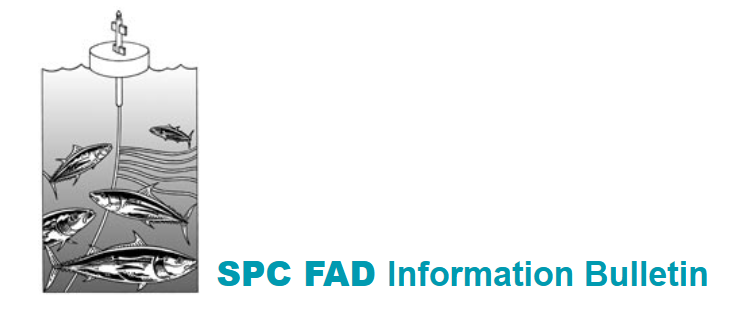
Group Coordinator
Production
Pacific Community, Fisheries Aquaculture and Marine Ecosystems Division, Information Section, SPC, BP D5, 98848 Noumea Cedex, New Caledonia.
Produced with financial assistance from France
Editorial
Welcome to the first edition of the Fish Aggregating Device (FAD) Bulletin. This is the eighth special interest group (SIG) bulletin published by the Information Section of the SPC Coastal Fisheries Programme. Other bulletins concern: ciguatera, pearl oyster, beche-de-mer, trochus, traditional marine resource management and knowledge, fisheries education and training, and live reef fish.
First, we should clearly identify the field that will be covered by this bulletin. To quote our new SPC colleague Magnus Bergstrom: ‘A fish aggregating device is any method, object or construction used for the purpose of facilitating the harvesting of fish by attracting and thus aggregating them’. In fact, the expression FAD has become more restricted, to mean a man-made floating object, anchored or not, set up to aggregate fish (mostly pelagic species). This bulletin will first concentrate on subjects related to these types of FADs but may, if members show interest, extend its coverage to other aggregating structures such as artificial reefs (ARs).
A questionnaire (of which you will find a copy on the last page of this issue) has been widely distributed since August 1995 to identify the most important topics for our future SIG members, and the ones on which we could expect contributions.
Up to now, we have received almost a hundred replies. The five following subjects were the most often cited:
1. FADs for small-scale commercial and subsistence use
2. Fish behaviour in association with FADs
3. Social and economic effects of FADs
4. FAD fishing techniques
5. Developments in FAD technology/materials
This publication is organised in three main sections: The first will present original contributions on general matters.
In this issue, one article by F. Conand and E. Tessier (page ) presents the FAD programme of La Réunion Island in the Indian Ocean. Another by K. Kikutani (page. ) explains the way fishermen have set up and run their own FAD programme through their cooperative on the Japanese Okunoshima Island. It is very interesting to note that in both cases FADs have created an important new source of income for artisanal fishermen and, in both cases also, fishermen have taken up themselves the management of the FAD programme. In the next issue we hope to publish an article by K. Holland and F. Marsac on the behaviour of fish related to FADs.
The second section will will be dedicated to the technical side of FADs, including FAD design and construction, and fishing techniques.
We begin this section with an article by Peter Cusack, SPC’s Fisheries Development Adviser, who presents the two FAD systems recommended in the handbook: ‘Rigging deep-water FAD moorings’ (in press). Knowing how critical design and construction are for the success of a FAD programme, we hope that the comparison of the different designs will offer enough information and provoke sufficient debate to create the ‘perfect FAD’ (‘the one that cost almost nothing and last forever’). In the next issue we will present the FAD designs used in French Polynesia and La Réunion.
F. Leproux and G. Moarii discuss the latest developments of the ancestral ‘dropstone’ fishing technique that is commonly used around FADs by artisanal fishermen of French Polynesia.
The last section will be reserved for abstracts and reviews. For this first issue I have tried to present a wide spectrum of subjects related to FADs in order to allow you to evaluate the richness of the subject.
However, as a newsletter, the bulletin should stay informal and informative, and this initial plan is expected to be ‘shaken-up’. It is a co-operative venture: you are encouraged (and as the actual co-ordinator, I should probably say: begged, beseeched, compelled or obliged, whatever works) to share what you are doing with all of us, and thereby become part of the wider network of FAD people. Any and all contributions are welcome, whether they be news, reports of recent progress, formal announcements, recent publications, reviews or abstracts.
As an information service, we also hope to include in each issue a regular listing of recent publications. We will start in the next issue with the list of publications related to FADs that are held by the SPC library. If you have published recently, please let us know.We hope to publish reviews of the most relevant literature, to help make it more accessible.
I would like to emphasise one point for the would-be contributors: SPC has an excellent translation section, and this bulletin will be published in English and in French. Thus, this publication provides a unique (and free!) opportunity to reach new readers and increase your sphere of influence...
I will end this editorial by saying that articles for all other SIG Bulletins are prepared for publication by an editor external to the SPC. I am convinced that there must be someone with hidden editorial talents amongst you. Although being a little time-consuming, the editor’s role gives the opportunity to be directly in contact with fisheries workers and scientists from all over the world. If you are interested, don’t hesitate to contact us for more information.
Aymeric Desurmont
Contents
- FAD deployments around Réunion Island by F. Conand & E.Tessier
- The FAD project of Tokunoshima Fishery Cooperative by K. Kikutani, T.Toyoshima & I.Tokuda
- Two FAD systems recommended by SPC by P. Cusack
- The drop-stone technique used by artisanal fishermen in French Polynesia by G. Moarii & F. Leproux
READINGS
- The assessment of the interaction between FADs and artisanal fisheries by J. Anderson

